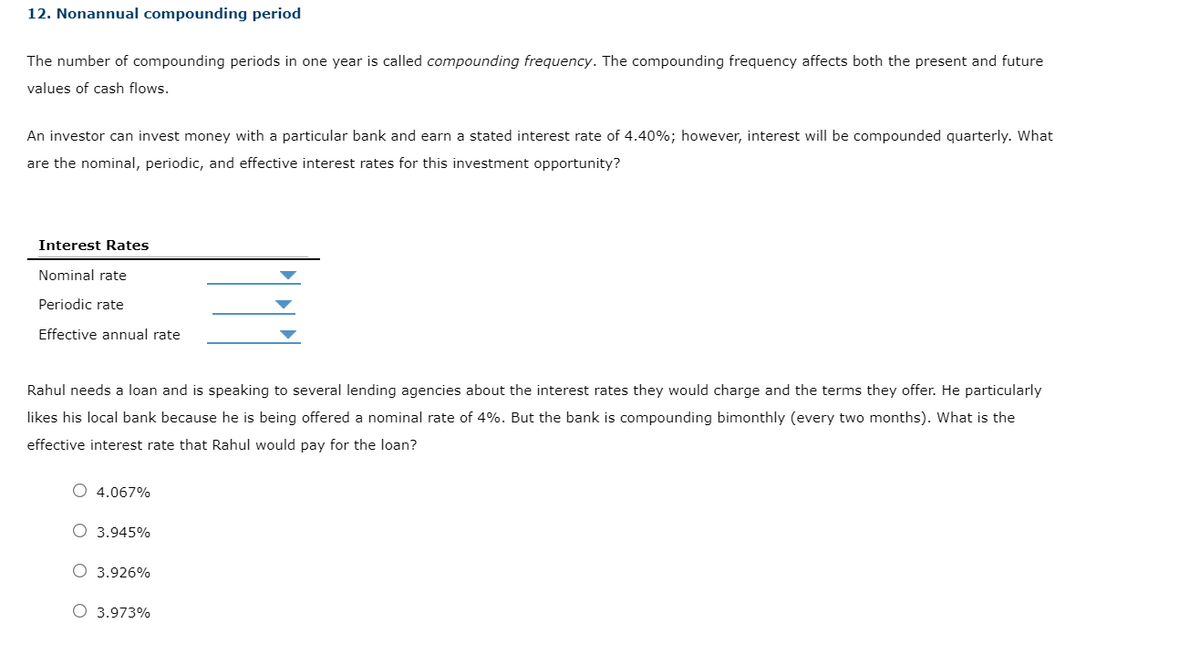Another bank is also offering favorable terms, so Rahul decides to take a loan of $12,000 from this bank. He signs the loan contract at 5% compounded daily for 12 months. Based on a 365-day year, what is the total amount that Rahul owes the bank at the end of the loan's term? (Hint: To calculate the number of days, divide the number of months by 12 and multiply by 365.) O $12,236.75 O $12,362.91 O $12,489.06 O $12,615.21
Another bank is also offering favorable terms, so Rahul decides to take a loan of $12,000 from this bank. He signs the loan contract at 5% compounded daily for 12 months. Based on a 365-day year, what is the total amount that Rahul owes the bank at the end of the loan's term? (Hint: To calculate the number of days, divide the number of months by 12 and multiply by 365.) O $12,236.75 O $12,362.91 O $12,489.06 O $12,615.21
Financial Management: Theory & Practice
16th Edition
ISBN:9781337909730
Author:Brigham
Publisher:Brigham
Chapter4: Time Value Of Money
Section: Chapter Questions
Problem 8MC: Define the stated (quoted) or nominal rate INOM as well as the periodic rate IPER.
Will the future...
Related questions
Concept explainers
Question

Transcribed Image Text:Another bank is also offering favorable terms, so Rahul decides to take a loan of $12,000 from this bank. He signs the loan contract at 5%
compounded daily for 12 months. Based on a 365-day year, what is the total amount that Rahul owes the bank at the end of the loan's term? (Hint:
To calculate the number of days, divide the number of months by 12 and multiply by 365.)
O $12,236.75
O $12,362.91
O $12,489.06
O $12,615.21

Transcribed Image Text:12. Nonannual compounding period
The number of compounding periods in one year is called compounding frequency. The compounding frequency affects both the present and future
values of cash flows.
An investor can invest money with a particular bank and earn a stated interest rate of 4.40%; however, interest will be compounded quarterly. What
are the nominal, periodic, and effective interest rates for this investment opportunity?
Interest Rates
Nominal rate
Periodic rate
Effective annual rate
Rahul needs a loan and is speaking to several lending agencies about the interest rates they would charge and the terms they offer. He particularly
likes his local bank because he is being offered a nominal rate of 4%. But the bank is compounding bimonthly (every two months). What is the
effective interest rate that Rahul would pay for the loan?
O 4.067%
O 3.945%
O 3.926%
O 3.973%
Expert Solution
This question has been solved!
Explore an expertly crafted, step-by-step solution for a thorough understanding of key concepts.
This is a popular solution!
Trending now
This is a popular solution!
Step by step
Solved in 2 steps

Follow-up Questions
Read through expert solutions to related follow-up questions below.
Follow-up Question

Transcribed Image Text:12. Nonannual compounding period
The number of compounding periods in one year is called compounding frequency. The compounding frequency affects both the present and future
values of cash flows.
An investor can invest money with a particular bank and earn a stated interest rate of 4.40%; however, interest will be compounded quarterly. What
are the nominal, periodic, and effective interest rates for this investment opportunity?
Interest Rates
Nominal rate
Periodic rate
Effective annual rate
Solution
Knowledge Booster
Learn more about
Need a deep-dive on the concept behind this application? Look no further. Learn more about this topic, finance and related others by exploring similar questions and additional content below.Recommended textbooks for you


EBK CONTEMPORARY FINANCIAL MANAGEMENT
Finance
ISBN:
9781337514835
Author:
MOYER
Publisher:
CENGAGE LEARNING - CONSIGNMENT



EBK CONTEMPORARY FINANCIAL MANAGEMENT
Finance
ISBN:
9781337514835
Author:
MOYER
Publisher:
CENGAGE LEARNING - CONSIGNMENT


Managerial Accounting: The Cornerstone of Busines…
Accounting
ISBN:
9781337115773
Author:
Maryanne M. Mowen, Don R. Hansen, Dan L. Heitger
Publisher:
Cengage Learning

Cornerstones of Cost Management (Cornerstones Ser…
Accounting
ISBN:
9781305970663
Author:
Don R. Hansen, Maryanne M. Mowen
Publisher:
Cengage Learning